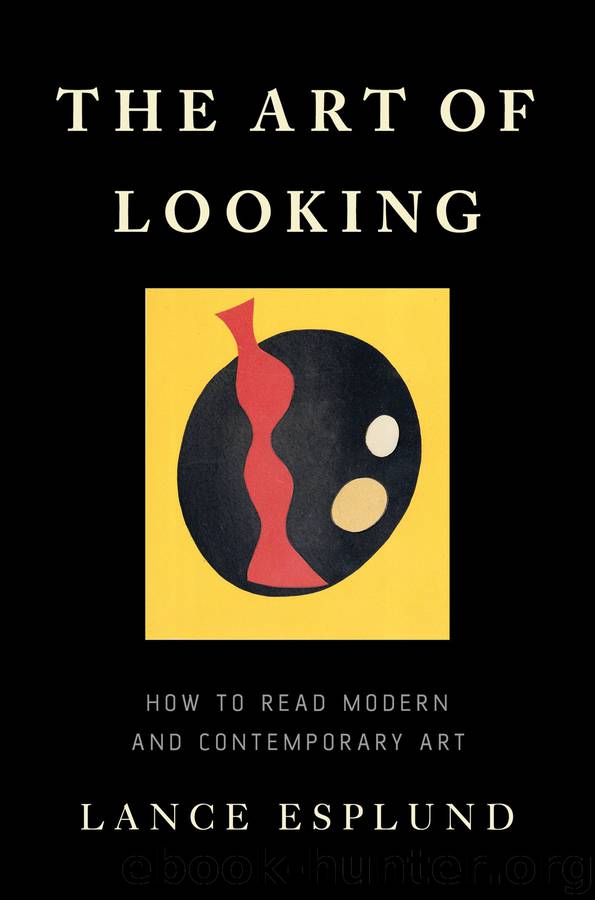The Art of Looking by Lance Esplund

Author:Lance Esplund
Language: eng
Format: epub
Publisher: Basic Books
Published: 2018-11-26T16:00:00+00:00
IMMERSING MYSELF IN Balthus’s painting of a nude girl, a cat, and a mirror, I’m reminded of nighttime and moonlight, and of the seductress Venus, the goddess of sex, beauty, and victory, who represents sacred and profane love, and who is often depicted with a mirror. And I think of Diana, the goddess of nature, the moon, the hunt, and wild animals, which she held under her spell. I’m reminded that our ancient ancestors used to perform the hunt at night, by the light of the moon, when animals were sleeping and more vulnerable, and that their guide, the female goddess of the moon, was often deemed higher than her male counterpart, the god of the sun. I’m aware that the shining yellow mirror in the painting’s nocturnal, maroon field is sun to the girl’s bluish moonlight; that she is beautiful yet eerie, suggesting ancient monument and child. I wonder if she is lit, bathed bluish by moonlight, or if she is the glowing moon or moonlight personified. As the painting gets my mind going, I’m reminded that it was often at night, in the stillness and darkness of my own childhood bedroom, just before sleep, that my imagination often flitted among memory and fantasy, dreamy and nightmarish places.
Balthus’s painting inspires this kind of free association, imagination, and nostalgia, but the painting’s various qualities take you much further than down memory lane, and they never allow you to stay in one place for very long. The flesh in Balthus’s nude girl, though believable as human and youthful, is about as mysterious as any skin I have ever seen in a painting. Built up out of multiple layers of opaque and translucent color, the girl’s flesh is difficult to navigate. Glowing from within, it actually is mostly pale bluish (though sometimes pearlescent white or pale ivy or golden or rose), and flits from silken to chalky to translucent to opalescent. Her warm lips, cheekbones, and sex are burnished pink, and her skin and hair shine in places, as if gilded. She evokes artifacts, chrysalis, and peeling fresco. Nothing here, however, is overt or fixed. Balthus keeps everything in stages of possibility and transition. The painting’s associations, registering in flashes, build poetically and remain always in motion and at play, as if the canvas and its forms were undergoing alchemical transformation, as if she were as fleeting and malleable as fantasy.
Download
This site does not store any files on its server. We only index and link to content provided by other sites. Please contact the content providers to delete copyright contents if any and email us, we'll remove relevant links or contents immediately.
The Secret History by Donna Tartt(18166)
Red Sparrow by Jason Matthews(5198)
Harry Potter 02 & The Chamber Of Secrets (Illustrated) by J.K. Rowling(3556)
In a Sunburned Country by Bill Bryson(3369)
Drawing Cutting Edge Anatomy by Christopher Hart(3290)
Figure Drawing for Artists by Steve Huston(3272)
The Daily Stoic by Holiday Ryan & Hanselman Stephen(3110)
Harry Potter and the Prisoner of Azkaban (Book 3) by J. K. Rowling(3110)
Japanese Design by Patricia J. Graham(3002)
The Roots of Romanticism (Second Edition) by Berlin Isaiah Hardy Henry Gray John(2820)
Make Comics Like the Pros by Greg Pak(2758)
Stacked Decks by The Rotenberg Collection(2687)
Harry Potter and the Deathly Hallows (7) by J.K. Rowling(2551)
Draw-A-Saurus by James Silvani(2504)
Tattoo Art by Doralba Picerno(2488)
On Photography by Susan Sontag(2486)
Foreign Devils on the Silk Road: The Search for the Lost Treasures of Central Asia by Peter Hopkirk(2388)
Churchill by Paul Johnson(2364)
The Daily Stoic by Ryan Holiday & Stephen Hanselman(2344)
